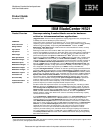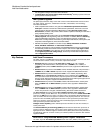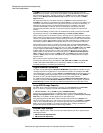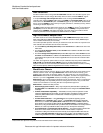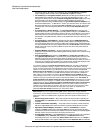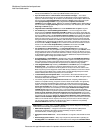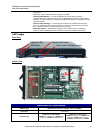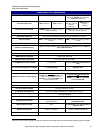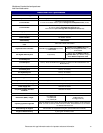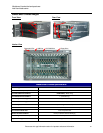
Workhorse 2-socket dual and quad-core
Intel Xeon blade server
Please see the Legal Information section for important notices and information.
2.
The various BladeCenter chassis are designed to monitor environmental conditions in the
chassis and each blade and send alerts to the administrator. Advanced standard features, such
as Active Memory
™
, Predictive Failure Analysis
™
, light path diagnostics, hot-swap
redundant power supplies and blower modules with Calibrated Vectored Cooling
™
; IPMI
2.0 support, including highly secure remote power control; text-console redirect over LAN,
a Management Module (upgradeable with a redundant MM), IBM Director management
software including IBM PowerExecutive
™
, Remote Deployment Manager, and IBM
ServerGuide
™
help maintain system availability with increased uptime.
If you need highly manageable, high-performance computing power in a space- or power-
constrained environment, the HS21 is the ideal system.
Selling Features
Price/Performance
• There is an HS21 model to fit all budgets. The HS21 offers a choice of high-performance multi-core
Xeon processors with low-power draw, 64-bit extensions, either a 1066MHz or a 1333MHz front
side bus and either 8MB or 4MB (processor-specific) of shared integrated Level 2 cache.
• Low-voltage processors draw less power and produce less waste heat than high-voltage
processors, thus helping to reduce data center energy costs. Some dual-core Xeon processors use
only 65W. This is half the wattage consumed by older 130W processors. On a per-core basis, the
80W quad-core processors are even more economical, consuming only 20W per core, vs. 32.5W
per core for the 65W dual-core processors. For even lower dual-core power utilization, consider
processors operating at 40W and even 35W (20W and 17.5W per core, respectively.)
• Fully buffered PC2-5300 ECC memory operates at 667MHz with dual-interleaving, for high
performance.
• Selected HS21 blade servers are NEBS3/ETSI-compliant and feature long-life availability. These
blades are ideal for telecom or Next Generation Network (NGN) applications such as IPTV, IP
Multimedia Subsystem (IMS) and security.
• The extremely high degree of integration in the various BladeCenter chassis reduces the need
for server components, replacing numerous fans, KVM and Ethernet cables, power supplies,
external switches and other components with fewer shared hot-swap/redundant components in the
BladeCenter chassis itself. This integration also can greatly reduce the amount of power
consumed and heat produced, relative to an equivalent number of 1U servers. This can
significantly reduce a data center’s power bill. The reduced datacenter footprint can also save on
infrastructure cost.
• The chassis midplane provides high-speed blade-to-blade, blade-to-switch-module and
module-to-module communication internally as well as externally. The midplane in the
BladeCenter H provides four 10Gb data channels to each blade, and supports 4X InfiniBand and
10Gb Ethernet high-speed switch modules.
• The various BladeCenter chassis use ultrahigh efficiency power supplies. Most industry-
standard servers use power supplies that are between 65-75% efficient at converting power from
AC wall current to the DC power used inside servers. BladeCenter power modules can be more
than 90% efficient. This helps save even more money, as more of the power input you are paying
for is used for processing, rather than released into the data center as waste heat.
• BladeCenter also reduces the number of parts required to run the system. Sharing fans, systems
management, floppy devices and media means fewer parts to buy and maintain, and fewer items
that can bring the solution down.
Flexibility
The HS21 has the ability to grow with your application requirements, thanks to:
• Up to two multi-core Xeon processors (four or eight cores in all).
• Up to 16GB (standard) or 32GB (using the optional Memory and I/O Expansion Unit) of high-
speed fully buffered 667MHz PC2-5300 DDR2 error checking and correcting (ECC) system
memory with optional Chipkill protection.
• Up to two internal 2.5-inch SAS HDDs, up to three 2.5-inch SAS HDDs in an adjacent Storage and
I/O Expansion Unit, and access to terabytes of external IBM System Storage
™
and IBM
TotalStorage
™
SAN and NAS storage devices. 2.5-inch drives consume approximately half the
power of 3.5-inch drives.
• Two Gigabit Ethernet ports standard; plus more, using either a 2-port Gigabit Ethernet Expansion
Card, a Memory and I/O Expansion Unit, or a PCI I/O Expansion Unit II.
In addition, the various BladeCenter chassis offer a high degree of flexibility:
• A 30mm HS21 blade server can be upgraded, via a Memory and I/O Expansion Unit to a double-
wide HS21 (with expanded capabilities). With or without the Memory and I/O Expansion Unit, the
blade can be expanded further with a Storage and I/O Expansion Unit and/or a PCI I/O
Expansion Unit. This expandability allows configurations that are 30mm, 60mm, 90mm or 120mm



